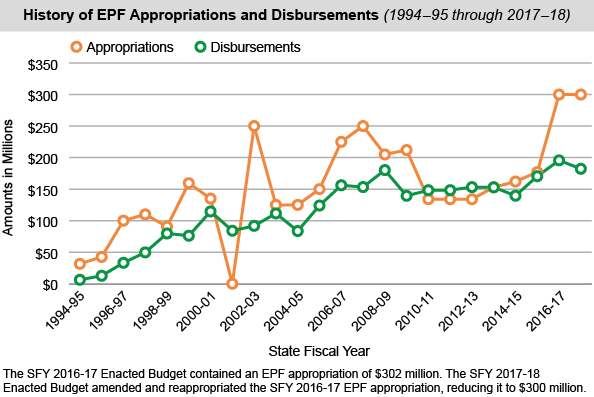Environmental Protection Fund (EPF)
Created in 1993, the EPF:
- Provides an ongoing source of primarily pay-as-you-go funding to address the State’s environmental needs.
- Supports a broad array of environmental programs, such as State and municipal open space conservation; municipal and agricultural non-point source water pollution control; State and local parks projects; municipal water pollution control and aquatic habitat conservation; support for the State’s zoos, botanical gardens and aquaria; waterfront revitalization; farmland conservation; and municipal climate change mitigation and resilience programs.
- Has been primarily funded with a portion of the State’s real estate transfer tax. However, from SFY 2014-15 through SFY 2017-18, General Fund Transfers were also a recurring funding source and accounted for 24 percent of EPF funding.
- Appropriations to the EPF have fluctuated over the life of the Fund. In SFY 2017-18, the EPF appropriation was $300 million.
Water
- A $2.5 billion capital projects appropriation was included in the SFY 2017-18 Enacted Budget for clean water infrastructure projects, including those projects authorized by the New York State Clean Water Infrastructure Improvement Act of 2017. Eligible projects include nonagricultural nonpoint source control; municipal waste water treatment; remediation of contaminated sites that contribute to water contamination; source water protection; and upgrades to septic systems and cesspools.
Other Appropriations
- Appropriations in SFY 2017-18 also included the following to the capital budgets of the:
- Department of Environmental Conservation for $70 million for various purposes including remediation of environmental contamination; dam safety projects and the demolition of unsafe structures on State-owned land; State land stewardship; public access and environmental recreation infrastructure projects; and
- Office of Parks, Recreation and Historic Preservation for $122.5 million to maintain and upgrade infrastructure at State Parks facilities and to maintain ski lifts and other Olympic Regional Development Authority facilities.
Energy
According to the U.S. Energy Information Administration:
- In 2016, New York State had the most energy efficient economy among U.S. states, consuming 2.9 thousand British Thermal Units (BTUs) for every dollar of gross domestic product.
- In 2016, New York State consumed 184.6 million BTUs per capita, second lowest among U.S. states. With energy consumption of 176 million BTUs per capita, Vermont had the lowest average energy consumption.
- With energy expenditures of $2,524 per person, New York State had the lowest per capita energy expenditures of any state in 2016.
- New York State’s March 2018 average residential natural gas price of $12.06 per thousand cubic feet was 12th in the nation.
- At 18 cents per kilowatt hour, New York State’s April 2018 average residential electric rate was eighth in the nation.
Agriculture
According to the U.S. Department of Agriculture:
- In 2017, receipts from the sale of all agricultural commodities in New York State were approximately $5.2 billion.
- With total receipts of $343 million, New York State was the second largest apple producer in the nation in 2017.
- New York State was the third largest milk producer in the nation in 2017, with total sales of $2.7 billion.

